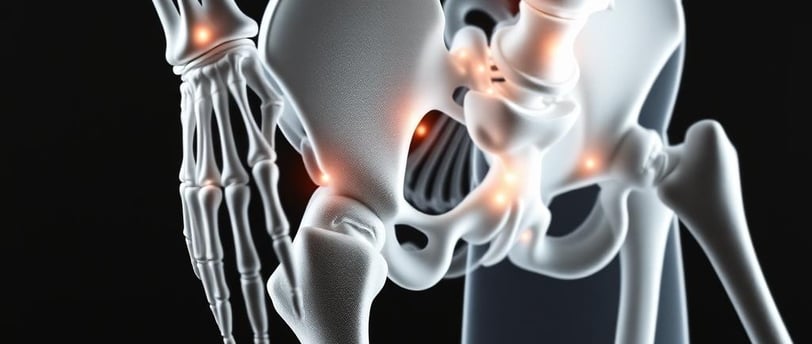Herbal Remedies for Osteoporosis: A Natural Approach Backed by Science
Blog post description.
🌿HERBAL REMEDIES


Osteoporosis is one of the most common bone conditions affecting millions globally, predominantly women after menopause but also men as they age. Characterized by weakened bones prone to fractures, osteoporosis can significantly compromise quality of life. Treatments often include medications and dietary adjustments, but there is growing interest in natural and herbal remedies that promote bone health. Backed by scientific evidence, these remedies can complement conventional treatments to improve bone density, reduce fracture risk, and support overall skeletal health.
This article delves into herbal remedies for osteoporosis, exploring their forms (tea, capsule, oil), scientific backing, dosage guidelines, precautions, and even an easy-to-follow recipe for bone-strengthening herbal tea.
Understanding Osteoporosis and the Role of Herbal Remedies
Osteoporosis results from an imbalance between bone loss and bone regeneration. Factors such as hormonal changes, nutritional deficiencies, and sedentary lifestyles compound this issue. While pharmaceutical interventions like bisphosphonates and hormone therapy remain the mainstay of treatment, there is growing evidence that herbal remedies can serve as a valuable complement.
Herbs are a rich source of micronutrients, flavonoids, phytoestrogens, and antioxidants, all of which play critical roles in bone remodeling and regeneration. The natural compounds found in herbs have shown promise in improving bone mineral density, reducing bone resorption, and stimulating the formation of new bone tissue.
Scientific Backing for Herbal Remedies
Science increasingly supports the efficacy of herbal remedies for osteoporosis. For example:
Red Clover (Trifolium pratense)
Rich in isoflavones, red clover mimics estrogen in the body, which can help combat postmenopausal bone loss. A study published in the Journal of Clinical Nutrition found that red clover supplementation significantly improved bone mineral density in postmenopausal women.Horsetail (Equisetum arvense)
Horsetail contains silica, an essential mineral for bone development. In vitro studies have shown that silica contributes to the synthesis of collagen, a key component of the bone matrix.Turmeric (Curcuma longa)
Curcumin, the active ingredient in turmeric, has anti-inflammatory properties that have been demonstrated to mitigate bone loss and promote bone regeneration in animal studies.Black Cohosh (Cimicifuga racemosa)
Used traditionally to treat menopausal symptoms, black cohosh also supports bone health by mimicking estrogen-like activity, reducing the risk of fracture.Dandelion (Taraxacum officinale)
Known for its high calcium content, dandelion can serve as a supplemental source of this critical mineral. Studies suggest that consuming calcium-rich herbs like dandelion can bolster bone density and reduce the risk of osteoporosis.
Common Forms of Herbal Remedies
Herbs for osteoporosis can be consumed in various forms. Each offers unique benefits and is tailored to individual preferences or therapeutic targets:
Tea Form
Herbal teas are convenient and soothing. Red clover tea, horsetail tea, or dandelion tea can be brewed to extract the active compounds needed for bone support.Capsules or Tablets
Capsules offer a concentrated and standardized dose of herbal extracts, ensuring consistent intake of bioactive compounds. This form is popular for turmeric, black cohosh, and red clover.Oil Form
While less common, herbal-infused oils can be applied topically to alleviate pain and swelling around joints and bones. For instance, turmeric oil or horsetail-infused oil may be beneficial.
Suggested Dosages and Precautions
Dosage:
Red Clover: 40–80 mg of isoflavones daily (as tea or capsule).
Horsetail: 300–400 mg daily, or 2–3 cups of tea made with 1–2 teaspoons of dried horsetail.
Turmeric/Curcumin: 500–1000 mg of curcumin daily, often taken in capsule form with black pepper to enhance absorption.
Black Cohosh: 20–40 mg daily, typically in capsule form.
Dandelion: 1–2 cups of tea or up to 500 mg in capsule form daily.
Precautions:
Red Clover: May interfere with hormone-sensitive conditions or medications like blood thinners. Always consult a healthcare provider before use.
Horsetail: Prolonged use can lead to thiamine deficiency. It is advisable to rotate its use with other remedies.
Turmeric: High doses may cause gastrointestinal discomfort or interact with anticoagulants.
Black Cohosh: Not recommended for individuals with liver problems.
Dandelion: May cause allergic reactions in people sensitive to plants in the daisy family.
It’s essential to consult a licensed medical professional or herbalist before starting any new herbal regimen, especially for osteoporosis management.
Herbal Recipe: Bone-Strengthening Tea
Here’s a simple recipe to prepare a nutrient-packed herbal tea for osteoporosis:
Ingredients:
1 teaspoon dried red clover flowers
1 teaspoon dried horsetail
1 teaspoon dried dandelion leaves
1 teaspoon dried nettle leaves (rich in calcium and magnesium)
2 cups water
Instructions:
Combine all the dried herbs in a teapot or infuser.
Bring 2 cups of water to a gentle boil.
Pour the hot water over the herbs and let steep for 10–15 minutes.
Strain the tea and enjoy. You can sweeten it with honey if desired.
Drink one to two cups daily as part of your osteoporosis management routine.
Lifestyle Integration
In addition to herbal remedies, maintaining strong and healthy bones necessitates a multifaceted approach, including:
Weight-bearing exercises such as walking, yoga, or resistance training.
Adequate intake of calcium (1000–1200 mg daily) and vitamin D (600–800 IU daily) through diet and supplements.
Avoidance of smoking and excessive alcohol.
Herbal remedies can work synergistically with these lifestyle changes to deliver optimal bone health benefits.
Conclusion
Herbal remedies for osteoporosis offer scientifically backed, easy-to-incorporate solutions for supporting bone health. Whether consumed as tea, capsules, or oils, herbs like red clover, horsetail, turmeric, black cohosh, and dandelion provide a natural alternative or complement to conventional treatment options.
While these remedies show immense promise, they should be used with caution, adhering to recommended dosages and consulting a healthcare provider to avoid potential interactions or side effects. With the right combination of herbs, proper nutrition, and a healthy lifestyle, you can build stronger bones naturally and enjoy an active, fracture-free future.
